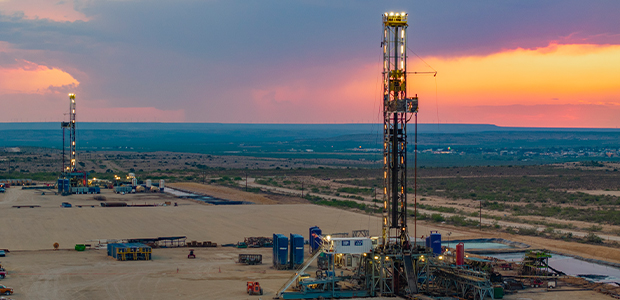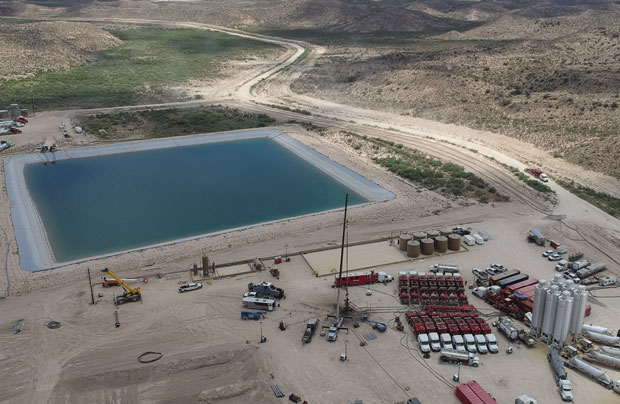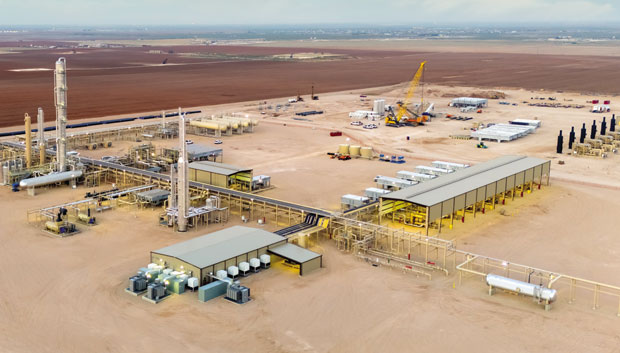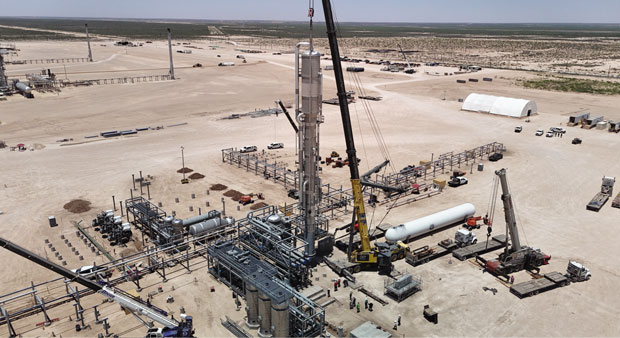
Innovative Solutions Drive Success Of Players In Permian Upstream, Midstream
By Danny Boyd
Anyone with the slightest oil and gas inkling knows the Permian Basin is king. But just how big is the role that the Permian is playing in today’s domestic industry?
A status summary from a Deloitte Research Center report sums it up nicely. Looking at full-year 2024, the Permian contributed 46% of total U.S. crude oil production, 20% of natural gas production, 51% of rig count activity, and nearly 40% of total upstream merger and acquisition deal value. That is one exceptionally large piece of the complete U.S. energy puzzle.
And while year-over-year production growth rates have slowed, the basin’s dominance keeps becoming more pronounced. Oil production is humming along at 6.5 million barrels a day—doubling 2018’s average daily output—while natural gas production is now north of 25 billion cubic feet a day—more than doubling daily volumes in 2018. It is an astonishing tale of oil and gas growth in a 100-year-old petroleum province, but one that at times has been dominated by a nagging recurring storyline: takeaway capacity constraints that effectively bottleneck production flowing to both U.S. and international markets.
Consequently, as operators such as Vital Energy Inc. and non-operators like Granite Ridge Resources Inc. leverage technological advancements and innovative business models to optimize Permian resource plays, midstream companies such as Brazos Midstream and Vaquero Midstream are building out infrastructure to help operators gather, process, and transport supplies to end users at home and abroad.
A series of transactions over the past five years has helped Vital Energy build an 81,500-acre position in the Delaware Basin and expand to 191,500 acres in the Midland Basin. Now the Tulsa-based company is shifting its focus to development and relying more on “J-hook” and “horseshoe” laterals to maximize lateral length and increase capital efficiency, says Chief Operating Officer Katie Hill.
After drilling and completing its first horseshoe laterals last year, Vital Energy has now drilled and completed its first two J-hook wells in the Wolfcamp B in a Delaware Basin lease in Reeves County, Tx. The modified horizontal architectures are reducing per-barrel development costs without sacrificing production.
In May, Vital was completing its first two 15,000-foot J-hook wells in the Wolfcamp B on a space-constrained Delaware Basin lease in Reeves County, Tx.
On the first well, Vital drilled 5,000 feet in one direction before turning the bit 180 degrees and drilling an additional 10,000 feet, giving the well the shape of a J. After reaching total depth on the first well, the rig skidded over 20 feet and drilled a second J-hook in the opposite direction. Together, the two 15,000-foot J-Hook wells access 30,000 feet of reservoir, replacing the traditional method of drilling three 10,000-foot straight wellbores.
While the J-hook design is new for the company, Vital began drilling horseshoe laterals in mid-2024. The modified horizontals are saving money without sacrificing production, which is now at about 140,000 barrels of oil equivalent per day across the company’s Permian leasehold.
Lowering Break-Evens
“There is no production degradation on any of the horseshoe wells that we have brought online and some of them have been producing now for nine months or more,” Hill reports. “When we replace two 5,000-foot traditional wells with a single 10,000-foot horseshoe, we reduce break-even costs by $15-$20 per barrel. The J-hooks, which replaces three 10,000-foot wells with two 15,000-foot wells generates a $5-$7 per barrel breakeven reduction.”
To complete the shaped wells, the company was prepared to pump more friction reducer and change the chemical design due to the additional friction of the shaped wellbore. Fortunately, the company did not have to alter proppant, fluid, or pump horsepower, Hill reveals. The company is using dissolvable plugs to avoid drill-out issues in the end of the laterals, she details. The modified laterals help make the most of space-constrained leasehold and result in additional cost savings elsewhere while fully exploiting multiple stacked benches.
On its 8-Mile project in Midland County, 12 horseshoe laterals in the Middle and Lower Spraberry, Jo Mill, and Wolfcamp A and B are expected to improve capital efficiency by 30%. “The industry is at a point where the need for cost-efficient development is higher than ever, and as the Permian Basin has gotten more mature in the development profile, operators are having to get more creative,” Hill observes.
By demonstrating the success of the shaped wellbores, Vital can convert up to 135 straight 10,000-foot wells to 90 15,000-foot J-hooks. Of 925 total wells in inventory, about 10% are expected to be horseshoes. More shaped laterals are possible from an additional 250 wells that will be included in inventory pending further delineation in proven benches.
Operated Partnerships
With modified laterals improving returns, modified business models also play a role in Permian success. Publicly held non-operator Granite Ridge Resources Inc. is benefitting from operated partnerships with proven, private operator management teams in which the Dallas-headquartered company provides most of the capital and controls development timing, says President and Chief Executive Officer Luke Brandenberg.
So far, two partnerships are active in the Midland and Delaware basins, with one on the way. Granite Ridge is planning to spend 60% of $310 million in capital on the enterprises this year. About 65% of the company’s overall deal flow, including traditional non-op investment, is Permian focused.
Non-operator Granite Ridge Resources Inc. has two active partnerships in the Midland and Delaware basins, filling a void left by an industrywide decline in the availability of private equity funding, especially for smaller private players. Through operated partnerships and traditional non-operated working interests, Granite Ridge holds 18,044 net Permian acres with 899 gross wells.
Granite Ridge’s operated partnerships are different from the approach taken by private equity groups, explains Brandenberg, who conducted deals for more than a decade at a leading private equity firm. Private equity investments typically fund company launches to build positions and then sell the businesses in a more condensed timeline to bigger players seeking large chunks of inventory. Conversely, the operated partnerships focus on building sustainable businesses, completing full development of acquired assets, and selling oil and gas production over the long term.
Granite Ridge targets full-cycle returns greater than 25%, after allocating a portion of its working interests to its operating partners who meet defined investment return thresholds.
“We have all the control features that a private equity firm has, but it is at the asset level instead of the company level, Brandenberg says.
The collaborations effectively address an industrywide decline in private equity fundraising, especially for smaller players, and with word getting out, more private players are knocking on Granite Ridge’s door.
Results to date have been exceptional, Brandenberg says. In the past year, one Delaware Basin partner increased gross daily operated oil production by 400%, going from 2,500 to 10,000 barrels of oil a day in more than 50 producing wells.
In farmouts and similar arrangements, the partnerships also can drill less-explored benches on acreage owned by large public players who wish to avoid public perceptions of undo risk taking but also want to gather data to guide their own future developments, Brandenberg notes.
Gross acreage in the partnerships is up to 10,000 and counting. Through operated partnerships and traditional non-op working interests, Granite Ridge holds 18,044 net Permian acres with 899 gross wells that produce 63% of companywide production of more than 29,000 boe/d.
Overall, the company has amassed 47,243 net acres in the Permian, Haynesville, Eagle Ford, Williston, Denver-Julesburg, and Utica Shale basins. Its relationships cover 60% of industry activity nationally on 3,100 wells under 65 different operators, according to Brandenberg.
In either type of investment, due diligence is constant when scouting prospects. Last year, Granite Ridge reviewed 650 possible transactions totaling $5 billion in investment opportunities. Brandenberg says the company closed on or actively negotiated on 62 throughout its position.
In the Permian Basin, he adds that upside potential remains high for traditional non-operating investments that for Granite Ridge already include minority interests in wells operated by Diamondback Energy, ConocoPhillips, EOG Resources, Permian Resources, Mewbourne Oil, and others.
Midstream Expansion
With the Permian producing more natural gas, midstream players are expanding to meet needs for more gathering and processing. Brazos Midstream is aggressively building out its Midland Basin system and keeping an eye on the promising development of the Woodford Shale on dedicated acreage in the Delaware, says Chief Executive Officer Brad Iles.
Founded a decade ago, the Fort Worth-based company operates Delaware Basin midstream assets owned by Morgan Stanley that serve 24 clients through the 500 million cubic feet a day Comanche processing facility in Reeves County. About 70% utilized, the plant and its system connect to seven midstream providers for occasional offloading when volumes exceed capacity. Still, a plant addition could be warranted within the next couple of years, Iles says, given what is happening in the Woodford.
Brazos Midstream began operations at its 200 MMcf/d Sundance 1 cryogenic processing plant in southern Martin County, Tx., last fall. Capacity was full within three months. The company is now constructing Sundance 2, a 300 MMcf/d train at the same location with service expected to begin by year’s end. The company has also approved the 300 MMcf/d Cassidy 1 plant in Glasscock County, Tx., which is expected to be operational by the third quarter of 2026.
A lean gas development principally at the gassy Alpine High in the west, the play contains some oily and high-condensate zones as it trends eastward toward the Central Basin Platform.
“We are seeing some incredible well results that give us strong optimism about incremental volumes being developed,” Iles comments. “We have quite a bit of dedicated acreage prospective of this rich Woodford. We are optimistic that if it gets developed on a more accelerated pace, we may very well need to expand processing sooner.”
Expansion is well underway in the Midland Basin, where in 2021 the company launched Brazos Midland with backing from Old Ironsides Energy, EnCap Flatrock Midstream, and other investors.
In October, Brazos began operations at its fully electric, 200 MMcf/d Sundance 1 cryogenic processing plant in southern Martin County. Capacity was full within three months, Iles says, and the company has since launched construction on Sundance 2, a 300 MMcf/d train at the same location with service expected to begin by the end of this year. At Sundance, natural gas liquids are sold into a Oneok line and residue gas into WhiteWater’s Matterhorn Express Pipeline. More connections are expected to be added, Iles adds.
The company’s board has also approved the 300 MMcf/d Cassidy 1 plant in Glasscock County on the southern end of Brazos’ Midland Basin pipeline system. Cassidy 1 is expected to be operational by the third quarter of 2026. Cassidy 2, also a 300 MMcf/d plant in Glasscock County, could be added soon thereafter, with multiple takeaway connections anticipated.
Current plants and additions would expand total Midland Basin processing capacity to 1.1 Bcf/d. Current pipeline infrastructure can move upwards of 1.5 Bcf/d, Iles reveals.
Although expansion is challenged by delays in connecting to utility power, Iles insists that Brazos’ focus on execution and using advanced technologies allows it to compete with companies with 10 times its size and scale. As more existing gathering and processing contracts come to term in the coming years, Brazos can also take advantage of the opportunity to grow by replacing aging gathering lines managed by multiple midstream companies, Iles concludes.
Cryogenic Processing Plant
Dallas-headquartered Vaquero Midstream plans to launch operations next March on a third 200 MMcf/d cryogenic processing plant that is now under construction, says Chief Executive Officer Harrison Holmes. The addition brings total processing capacity on its system to 600 MMcf/d after adding similar plants in 2016 and 2018. Operational and installation efficiency at the newest facility is reinforced by existing power and downstream infrastructure.
A new 70-mile, 24-inch high-pressure pipeline loop doubles gathering capacity on Vaquero’s legacy system from 400 MMcf/d to 800 MMcf/d, Holmes points out. The line originates at the company’s processing complex near Waha and connects into its existing high-pressure pipeline in Loving County, increasing its gathering footprint through parts of Loving, Ward and Winkler counties.
Vaquero Midstream plans to commence operations early next year on a new 200 MMcf/d cryogenic plant that is now under construction in the state line area near the Waha Hub in Pecos County, Tx. A new 70-mile, 24-inch high-pressure pipeline loop also doubles gathering capacity on Vaquero’s legacy system from 400 MMcf/d to 800 MMcf/d.
“We feel very good about the position of the business,” Holmes relates. “The assets are in the core of the southern Delaware Basin in Texas, and we have fantastic coverage there. In terms of our clients in the upstream community, we have very strong relationships and have great confidence in their plans. As we look out over the next five years, there is a lot of planned activity from contracted producers on our system, and we are going to be prepared to support those efforts.”
When the pipe is completed by year’s end, the company will have upwards of 300 miles of gathering lines in operation.
The tailgates of its plants connect to four NGL carriers, including Enterprise’s Chapparal, Energy Transfer’s Lone Star, Phillips’ Epic, and Targa’s Grand Prix pipelines. Residue gas connects to 7 pipelines, including access to WhiteWater’s Whistler and Matterhorn Express through the Agua Blanca intra-basin gathering line.
A balance sheet with little debt has provided the flexibility to weather ups and downs since 2013 when Vaquero was established, as has consistent support from Yorktown Partners, whose oil and gas successes include private equity backing of Concho Resources, Brigham Resources, and others.
“We are fortunate that we have continued support from our private equity backer in Yorktown, and we have a team that is aligned and committed to being one of best service providers for gathering and processing in the Delaware Basin.”
For other great articles about exploration, drilling, completions and production, subscribe to The American Oil & Gas Reporter and bookmark www.aogr.com.



















